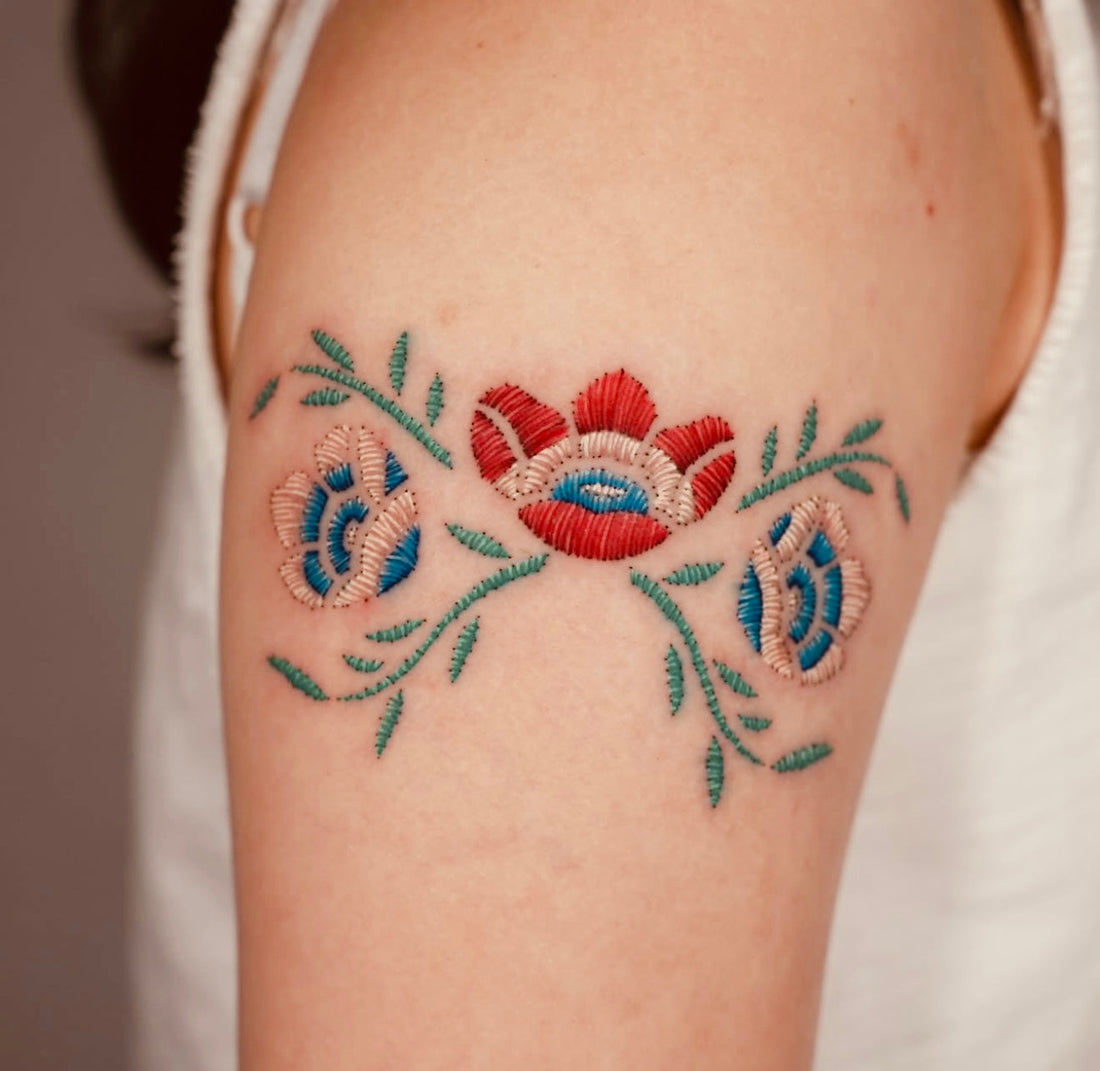
What Is an Embroidery Tattoo and Why Is It the Newest Ink Obsession?
What Is an Embroidery Tattoo?
An embroidery tattoo is a mesmerizing tattoo style that mimics the look of stitched thread on fabric. Instead of flat, shaded designs, embroidery tattoos give the illusion that the artwork is raised, textured, and sewn directly into the skin. Artists use vibrant colors and detailed line work to replicate cross-stitching, chain stitching, and patchwork designs, making the tattoo look like a piece of embroidered fabric.
Why Has Embroidery Tattoo Become a Fashion Trend?
The embroidery tattoo trend taps into a growing cultural fascination with craftsmanship, nostalgia, and uniqueness. In a world increasingly dominated by digital aesthetics, embroidery tattoos celebrate something handmade and tactile. The visual richness and depth also set them apart from traditional tattoos, offering a new canvas of creative self-expression.
Social media platforms like Instagram, Pinterest, and TikTok accelerated the trend, as highly photogenic embroidery tattoos quickly captured viewers' attention. Their vibrant 3D-like quality makes them ideal for sharing and has inspired both tattoo veterans and newcomers.

Is an Embroidery Tattoo More Difficult to Create?
Absolutely. The complexity of embroidery tattoos is significantly higher than that of regular tattoos. Artists must master:
- Creating convincing texture with ink.
- Using layering and subtle color variations to simulate threads.
- Maintaining clarity in extremely fine lines to replicate stitching.
Because embroidery tattoos demand precision and a strong grasp of color theory, not every tattoo artist is equipped to execute them properly.
Are There Any Risks Involved?
Like all tattoos, embroidery tattoos carry the standard risks: infection, allergic reactions, and scarring. However, because they involve highly detailed, layered work, there's a slightly higher risk of:
- Ink spreading (blowouts) if the artist goes too deep.
- Color distortion if healing is not carefully managed.
Choosing an experienced embroidery tattoo specialist and following strict aftercare is essential.
Does the Tattooing Process Differ from Regular Tattoos?
Yes, slightly. Because embroidery tattoos rely heavily on texture simulation, the tattooing sequence often involves:
- First outlining the "stitches."
- Then layering color shades meticulously.
- Finally adding highlights to give the "thread" a realistic raised effect.
This layering process is more intensive and methodical compared to conventional tattoos, where shading and coloring can be freer.
Can You Modify or Cover an Embroidery Tattoo Later?
It’s tricky. Due to their heavy detail and dense colors, embroidery tattoos are harder to modify or cover up cleanly. Trying to adjust them later often requires full laser removal or highly strategic reworking, which can be costly and time-consuming.
Who Popularized Embroidery Tattoos?
While no single celebrity "invented" embroidery tattoos, artists like Eva Karabudak (@evakrbdk) played a crucial role in popularizing the style on Instagram. Her hyper-detailed cross-stitch designs went viral around 2016-2018, inspiring a wave of artists worldwide to explore the technique.
Some pop culture icons and influencers with a flair for experimental body art, such as Halsey, have flirted with textured and illustrative tattoo styles, further fueling interest.

What Psychological Need Does This Trend Reflect?
Embroidery tattoos represent a craving for tangible artistry in an increasingly digital world. They evoke:
- Nostalgia for handcrafted traditions.
- Pride in uniqueness and personalization.
- A desire for textures and dimensions that "feel alive."
In a way, embroidery tattoos symbolize people’s yearning to stitch stories onto their skin—literally and emotionally.
Why Embroidery Instead of Other Art Forms?
Embroidery uniquely bridges art, fashion, and craft. Unlike flat paintings or minimalist linework, embroidery tattoos suggest effort and care. The association with handmade heirlooms, folk art, and clothing traditions gives them a rich, emotional depth that resonates widely.
Are There Health Risks Specific to Embroidery Tattoos?
Other than standard tattoo risks, embroidery tattoos demand extended sessions. This can mean longer skin trauma exposure, slightly elevating chances for:
- Overworking the skin.
- Uneven healing if aftercare is not meticulously followed.
Careful hygiene, professional technique, and patient healing are crucial.
How Long Does an Embroidery Tattoo Take?
A 5x5 cm (about 2x2 inch) embroidery tattoo typically takes 3 to 5 hours, depending on the intricacy. Compared to a regular tattoo of similar size, which might only take 1 to 2 hours, embroidery tattoos demand at least twice as much time due to the detailed layering.
What’s Next for Embroidery Tattoos?
Looking forward, we can expect even more creative expansions:
- Glow-in-the-dark threads using UV-reactive ink.
- 3D optical illusion patches blending realism and embroidery.
- Cultural embroidery motifs (like Sashiko from Japan or Otomi patterns from Mexico) gaining more spotlight.
Embroidery tattoos are more than a trend—they are a movement toward celebrating the imperfect, the handmade, and the richly human aspects of self-expression.
Explore more on how fabric, art, and fashion intersect at Topology Clothing's blog.
